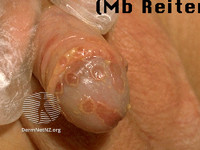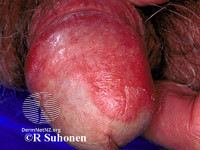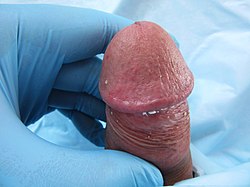Balanitis
| Balanitis | |
|---|---|
| Other names: Balanoposthitis | |
 | |
| Inflammation of the glans penis and the preputial mucosa of a circumcised penis (balanitis) | |
| Specialty | Urology |
| Symptoms | Redness, pain, discharge, itchiness, white patches[1] |
| Complications | Phimosis[1] |
| Causes | Infectious: Yeast, bacteria, viruses, trichomonas[1] Inflammation: Eczema, allergic reactions, lichen planus, psoriasis[1] Pre-cancerous: Bowen's disease, erythroplasia of Queyrat[1] |
| Risk factors | Uncircumcised, poor hygiene, diabetes, over cleaning[1][2] |
| Diagnostic method | Microbial culture, tissue biopsy[1] |
| Treatment | Foreskin retraction, washing the area[1] |
| Medication | Antifungal cream, antibiotics, steroid creams[1] |
| Prognosis | Usually good[3] |
| Frequency | 3 to 11% (males at some point)[4] |
Balanitis is inflammation of the head of the penis (glans).[1] It typically occurs together with inflammation of the foreskin (posthitis), which is called balanoposthitis.[1] Symptoms may include redness, pain, discharge, itchiness, or white patches.[1] Complication may include phimosis.[1]
Groups of causes include infectious (yeast, bacteria, viruses, trichomonas), inflammatory conditions (eczema, allergic reactions, lichen planus, psoriasis), and pre-cancerous conditions (Bowen's disease, erythroplasia of Queyrat).[1] Risk factors include being uncircumcised, poor hygiene, diabetes, or over cleaning.[1][2] Diagnosis may be based on microbial culture or other testing and occasionally tissue biopsy.[1]
General management involves keeping the foreskin retracted and washing the area.[1] Dilute vinegar (acetic acid 1%) may help.[2] Based on the specific cause antifungal cream (such as clotrimazole), antibiotics, steroid creams, or surgery.[1] Outcomes are usually good.[3] Between 3 and 11% of males are affected at some point in time.[4]
Signs and symptoms
- Small red erosions on the glans (first sign)
- Redness of the foreskin
- Redness of the penis
- Other rashes on the head of the penis
- Foul smelling discharge
- Painful foreskin and penis
-
Balanitis
-
Balanitis
-
Balanitis caused by smegma
Complications
Recurrent bouts of balanitis may cause scarring of the preputial orifice; the reduced elasticity may lead to pathologic phimosis.[5] Further complications may include:
- Stricture of urethral meatus
- Phimosis
- Paraphimosis
Cause
Inflammation has many possible causes, including irritation by environmental substances, physical trauma, and infection such as bacterial, viral, or fungal.[6][7] Some of these infections are sexually transmitted diseases.
It is less common among people who are circumcised, as in many cases, a dysfunction of the foreskin is a causal or contributing factor.[1] Both not enough cleaning and too much cleaning can cause problems.[1] Diabetes can make balanitis more likely, especially if the blood sugar is poorly controlled.[8]
It is important to exclude other causes of similar symptoms such as penile cancer.[1]
Diagnosis
Diagnosis may include careful identification of the cause with the aid of a good patient history, swabs and cultures, and pathological examination of a biopsy.[6]
Types
- Zoon's balanitis also known as Balanitis Circumscripta Plasmacellularis or plasma cell balanitis (PCB) is an idiopathic, rare, benign penile dermatosis[9] for which circumcision is often the preferred treatment.[9][10][11] Zoon's balanitis has been successfully treated with the carbon dioxide laser[12] and more recently Albertini and colleagues report the avoidance of circumcision and successful treatment of Zoon's balanitis with an Er:YAG laser.[13] Another study, by Retamar and colleagues, found that 40 percent of those treated with CO2 laser relapsed.[14]
- Circinate balanitis (also known as balanitis circinata) is a serpiginous annular dermatitis associated with reactive arthritis.
- Pseudoepitheliomatous keratotic and micaceous balanitis
Treatment
Initial treatment in adults often involves simply pulling back the foreskin and cleaning the penis.[1]
Epidemiology
Balanitis "is a common condition affecting 11% of adult men seen in urology clinics and 3% of children" in the United States; globally, balanitis "may occur in up to 3% of uncircumcised males".[15]
Other animals

In dogs, balanoposthitis is caused by a disruption in the integumentary system, such as a wound or intrusion of a foreign body. A dog with this condition behaves normally, with the exception of excessive licking at the prepuce, and a yellow green, pus-like discharge is usually present.
In sheep (rams/wethers), ulcerative enzootic balanoposthitis is caused by the Corynebacterium renale group (C. renale, C. pilosum & C. cystidis).
For the condition in bulls, caused by a virus see Bovine herpesvirus 1.
Balanoposthitis is believed to have contributed to the decline to near-extinction of Gilbert's potoroo.[16]
Word orgin
The word balanitis is from the Greek βάλανος balanos, literally meaning 'acorn', used because of the similarity in shape to the glans penis.[17]
References
- ↑ 1.00 1.01 1.02 1.03 1.04 1.05 1.06 1.07 1.08 1.09 1.10 1.11 1.12 1.13 1.14 1.15 1.16 1.17 1.18 1.19 1.20 1.21 Edwards, SK; Bunker, CB; Ziller, F; van der Meijden, WI (August 2014). "2013 European guideline for the management of balanoposthitis". International Journal of STD & AIDS. 25 (9): 615–26. doi:10.1177/0956462414533099. PMID 24828553. S2CID 127341.
- ↑ 2.0 2.1 2.2 "Balanitis | DermNet NZ". dermnetnz.org. Archived from the original on 26 March 2022. Retrieved 27 March 2022.
- ↑ 3.0 3.1 "Balanitis". Archived from the original on 24 March 2022. Retrieved 27 March 2022.
- ↑ 4.0 4.1 Wray, AA; Velasquez, J; Khetarpal, S (January 2022). "Balanitis". PMID 30725828.
{{cite journal}}: Cite journal requires|journal=(help) - ↑ Phimosis at eMedicine
- ↑ 6.0 6.1 Edwards S (1996). "Balanitis and balanoposthitis: a review". Genitourin Med. 72 (3): 155–9. doi:10.1136/sti.72.3.155. PMC 1195642. PMID 8707315.
- ↑ "Cleveland Clinic: Penile Disorders". Archived from the original on 2012-04-12. Retrieved 2012-04-10.
- ↑ Balanitis Archived 2016-04-19 at the Wayback Machine. Health Line. Retrieved 19 April 2016.
- ↑ 9.0 9.1 Keogh G. Balanitis circumscripta plasmacellularis at eMedicine
- ↑ Pellicé i Vilalta C, Casalots i Casado J, Cosme i Jiménez MA (1999). "[Zoon's balanoposthitis. A preliminary note]". Arch. Esp. Urol. (in español). 52 (1): 69–72. PMID 10101891.
- ↑ Buechner SA (2002). "Common skin disorders of the penis". BJU Int. 90 (5): 498–506. doi:10.1046/j.1464-410X.2002.02962.x. PMID 12175386. S2CID 45605100.
- ↑ Baldwin HE, Geronemus RG (1989). "The treatment of Zoon's balanitis with the carbon dioxide laser". J Dermatol Surg Oncol. 15 (5): 491–4. doi:10.1111/j.1524-4725.1989.tb03407.x. PMID 2497162.
- ↑ Albertini JG, Holck DE, Farley MF (2002). "Zoon's balanitis treated with Erbium:YAG laser ablation". Lasers Surg Med. 30 (2): 123–6. doi:10.1002/lsm.10037. PMID 11870791. S2CID 33098632. Archived (PDF) from the original on 2021-08-27. Retrieved 2019-07-01.
- ↑ Retamar RA, Kien MC, Chouela EN (2003). "Zoon's balanitis: presentation of 15 patients, five treated with a carbon dioxide laser". Int. J. Dermatol. 42 (4): 305–7. doi:10.1046/j.1365-4362.2003.01304.x. PMID 12694501. S2CID 21305117.
- ↑ Balanitis at eMedicine
- ↑ Vaughan-Higgins, Rebecca; Buller, Nicky; Friend, J. Anthony; Robertson, Ian; Monaghan, Cree L.; Fenwick, Stan; Warren, Kristin (2011). "Balanoposthitis, Dyspareunia, and Treponema in the Critically Endangered Gilbert's Potoroo (Potorous gilbertii)". Journal of Wildlife Diseases. 47 (4): 1019–1025. doi:10.7589/0090-3558-47.4.1019. PMID 22102677. S2CID 7279808. Archived from the original on 2019-11-15. Retrieved 2019-07-01.
- ↑ βάλανος. Liddell, Henry George; Scott, Robert; A Greek–English Lexicon at the Perseus Project.
External links
| Classification | |
|---|---|
| External resources |
- Zoon's Balanitis at eMedicine
- Dermatological atlas Archived 2012-02-06 at the Wayback Machine
- Edwards S. (for the Clinical Effectiveness Group) National guideline on the management of balanitis. Association for Genitourinary Medicine (UK) and the Medical Society for the Study of Venereal Diseases (UK), 2001.


